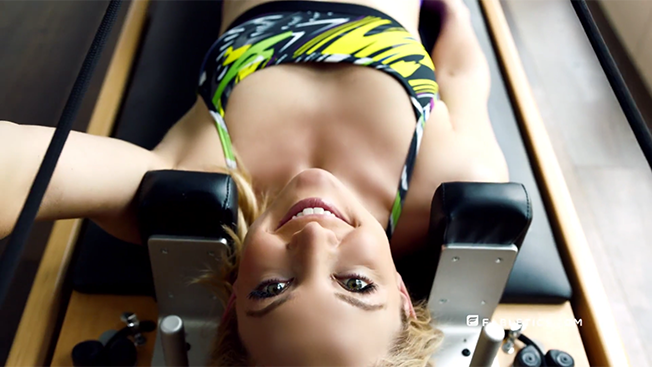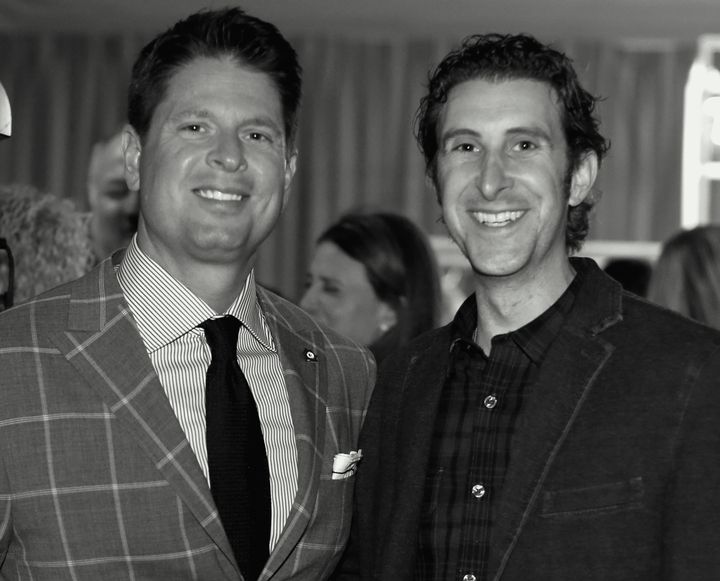
A casual visitor to TechStyle’s sleek modern offices, located in El Segundo right off Rosecrans Avenue on a block of gleaming commercial buildings, might think he’d arrived at a digital fashion media powerhouse or a tech start up rather than a successful apparel retailer.
Everywhere you look, company employees (overwhelmingly women) are cradling laptops as they go from glassed-in conference room, to high-ceilinged white-walled showroom to glass door offices and open-plan cubicles. There’s an in-house cafeteria, two photo studios, five edit bays, sample rooms with seamstresses from which designs are sent to overseas factories.
This is no accident. Techstyle, which changed its name this past August from JustFab, is very much trying to reinvent the fashion business for the 21st Century as the parent company of four online fashion companies, including Fabletics, the Kate Hudson-affiliated athletic leisure wear company.
Adam Goldenberg who co-founded the company in 2010 with Don Ressler has described the company as “Where Fashion Avenue meets Silicon Valley.” According to an August 2016 WWD article, Techstyle “has raised about $300 Million to date and is expected to end the year with $650 Million in revenue. Up about 29% from the year-ago period.” Fabletics makes up about 30% of that revenue. Unlike other retailers, Techstyle operates on a subscription membership model, whereby some 4 million online subscribers are paying $50 or $40 dollars a month to buy Techstyle’s branded apparel at a discount.
Shawn Gold, TechStyle’s Chief Marketing Officer, walked me through the company’s 120,000 square foot offices, a full third of which are devoted to media production, marketing and analytics. “Media, creative production and analytics are deeply weaved into the DNA of the company,” Gold said.
Fabletics makes more than 30 television spots a year in-house, of which there will be some 100-200 iterations. The ads, which can be found easily online, take a light humorous tone – one popular ad makes fun of a competitor brand’s yoga pants for being too “see through” (i.e. the problem Lululemon had); another, “Maximum Kate,” mocks the self-seriousness and feats of super-human strength often displayed in Under Armour or Nike ads, ending with Kate Hudson stopping the shoot to ask “Can’t we just say that Fabletics is cute styles girls are going to love?”
Hudson has been instrumental in the brand’s success. Ressler met Hudson, he recalled recently, “through a mutual friend” and was struck by how although she is, in his words, “an actress by trade” who has grown up on movie sets and in the industry, her authenticity shines through and that is what he “wanted Fabletics to represent” (not to mention her large social media following). In Hudson, Ressler said, he found a “a true co-founder partner that could help build the media side of this business and build Fabletics into the powerhouse in the athletic category that it is today.”
“Kate is very involved in the creative process,” Jason Stuckey, Executive Producer of Fabletics Media said. Stuckley screened an upcoming ad whose concept Hudson had suggested (in which she is filmed underwater) adding, “Any item Kate wears sales jump”. At the same time, Ressler later made the point that she is not in all the ads, “We have a plethora of people we shift in, Ressler said, “From our chief stylist to our various models. We never put all the pressure on Kate. It’s really a group of women that are passionate about the product. It’s about making all women feel good about themselves.”
Unlike a traditional fashion company, which is organized around seasonal collections, Fabletics produces a new collection, or story as they like to call it, each month. The clothes are priced, on average below direct competitors such as Lululemon, and even less for VIP members (i.e. subscribers). The media, paid, earned, and owned as well the emails campaigns and marketing announcements are all tweaked by a flood of data and analytics.
“It’s a non-stop conversation with our customers happening across multiple channels” said Laura Jones Joukovski, SVP Media & Analytics at TechStyle. Fabletics uses TV ads as well as paid digital advertising on social channels such as Facebook, Instagram, and Pinterest. “The channel that has been the most efficient for us in terms of dollars and translating into new customers is Facebook.” Joukovski said. “Static ads, link posts, we do video as well –They have a lot of interesting targeting opportunities as well as very sophisticated algorithms that helps us reach our target customers.”
Explaining that “you can get pretty granular.” Joukovski marveled at the “dizzying amount of personalization” that is possible. “The media buyers, our digital paid media buyers, which we spend a lot on, are literally looking at the results at the deepest level at the ad unit level every hour.” Ad budgets change all the time based on what’s working. “It’s real time. Which is kind of cool. Give the people what they want. We find out what people respond to and we really quickly adapt to that.”
Where all these ads and media is aimed is not just at reaching customers but at gaining more subscribers, dubbed VIP members. This is the secret sauce, or distinguishing factor in the Techstyle business model – a $49.95 recurring monthly fee for Fabletics that provides subscribers with deep discounts, or by which they can receive monthly boxes of outfits, a bedrock company practice that has generated some easily googled controversy.
How you feel about the membership model and the monthly fee is, to my mind, not unlike about how you might feel about your monthly gym membership – which is to say that membership has its benefits that you need to use to make them worthwhile. On the one hand, Fabletics has plenty of explanations and warnings on their website regarding how the membership works. They also have a failsafe option by which you can skip that month if you inform them in the first five days of any month. They also let you use that $49.95 as a credit in any month you make no purchase toward future purchases. Finally, there are clear explanations of how to cancel a membership.
That being said, and this is why gym memberships come to mind, some consumers have complained that they signed up without fully realizing the ongoing monthly commitment and that they found skipping a month or cancelling a membership difficult. When I went online to use the site, I found it easy to shop without becoming a member – although I didn’t realize at first that the $25 first outfit deal that is heavily promoted is contingent on membership – that did become clear as I spent more time on the site. When I didn’t sign up I continued to receive occasional emails urging me to join, but not at a frequency that I found to be an annoyance.
If Fabletics is an online media company with a membership/retail business rather than the other way around, it is because the parent company’s founders Adam Goldenberg and Don Ressler come from the online marketing world, not the retail world. They met as executives at Intermix, the incubator of online businesses such as MySpace, which was sold by its owners to News Corp at an enormous profit (only to become near valueless several years later). They are serial start-up entrepreneurs who have been involved in several women-directed online retail companies, some in the beauty space, many of which operated on a subscription basis (some with googleable controversies of their own). The other brands under TechStyle have all had, at one point, some celebrity affiliation JustFab (Kimora Lee), ShoeDazzle (Kim Kardashian), FabKids (Christina Applegate). But clearly Kate Hudson + Fabletics is the most seamless match of personality and product involvement.
The point is that if TechStyle and Fabletics seem more like online media companies than apparel retailers it is because that is precisely the business that Ressler and Goldenberg are expert in. Fabletics may just be the best and most successful iteration of the business model that they have been refining for a long, long time (at least in internet years).
What having those subscribers does, beyond assuring a predictable monthly income base, is provide the company with tremendous data about their customers and their shopping preferences. What that means for a fashion retail company is, Gold explained, is a better ability to produce apparel its customers will purchase, causing a far lesser number of returns.
As further proof that the tail is wagging the dog, Fabletics is about to open their 18th brick and mortar retail location. “We think we have a model that is omni-channel that marries everything that we are doing online,” Ressler said. The store’s locations are chosen based on being close to large concentrations of their VIP members and online purchasers who increase their purchases by visiting the retail locations.
Which brings me back to my original question: Is TechStyle and Fabletics a media company with retail or a retail company using media? The answer, per Ressler, is that to be successful today you need to be both. “I don’t think retail is dead,” he said, “But if you don’t have a unique, true omni-channel, have the online piece, have a grasp on your television, and marry all those pieces, you’re going to have a really tough time.”

